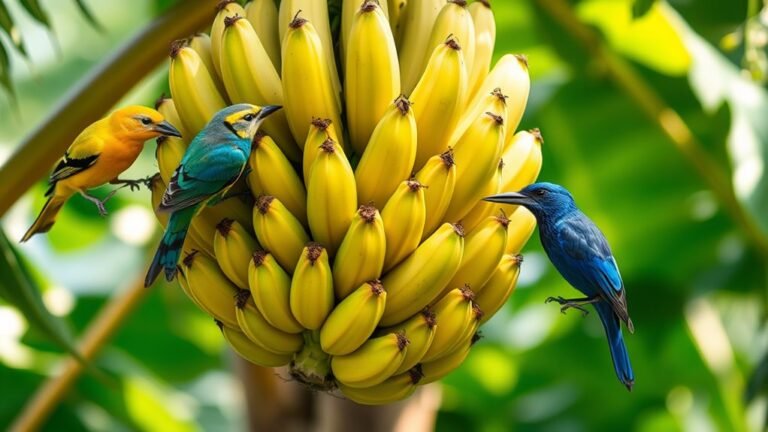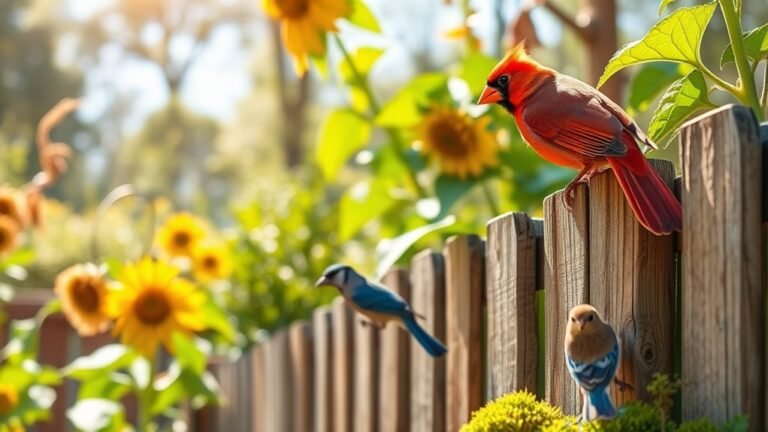Plants That Look Like Birds: Nature’s Artistic Mimicry
Plants that look like birds show nature's talent for mimicry. These plants use colors, shapes, and structures that resemble bird features. Examples include the colorful Parrot Flower and the graceful Lady's Slipper Orchids. Each plant's appearance serves a purpose in its growth and survival.
The resemblance to birds may attract pollinators or help with reproduction. This mimicry allows plants to thrive in their environments. Exploring these unique plants shows how evolution shapes adaptations for success in various ecosystems.
Key Takeaways
Plants That Look Like Birds: Nature's Artistic Mimicry
- The Parrot Flower has bright red, yellow, and green colors. It attracts attention in tropical gardens and supports biodiversity.
- Bird-of-Paradise flowers look like birds in flight. Their orange and blue petals appeal to pollinators and add beauty to gardens.
- Hummingbird Sage grows tubular flowers that attract hummingbirds. Its vibrant colors and sweet nectar thrive in sunny spots.
- Lady's Slipper Orchids feature pouch-like flowers that resemble bird wings. They symbolize love and luxury in various environments.
- The Flamingo Flower, with its heart-shaped spathes in multiple colors, resembles a flamingo. It flourishes in humid tropical areas.
Explore these fascinating plants and enjoy their unique beauty and roles in nature!
The Parrot Flower: A Colorful Resemblance

The Parrot Flower, scientifically named *Impatiens psittacina*, stands out for its bright colors and shape, which resemble exotic birds.
Its vivid reds, yellows, and greens reflect parrot symbolism, showing energy and creativity in nature.
This plant grows well in tropical gardens, needing humidity and shade to thrive.
By adding the Parrot Flower to your garden, you create a vibrant space that feels like a tropical paradise.
Its remarkable appearance sparks conversations about biodiversity and ecology.
Growing this beautiful flower helps connect you to the wonders of nature.
Enjoy the lively beauty it brings!
Bird-of-Paradise: The Tropical Icon
The Bird-of-Paradise (*Strelitzia reginae*) is a tropical plant known for its unique flowers. These blooms look like colorful birds in flight. They display bright orange and blue colors that attract attention and connect people to nature.
The plant thrives in sunny environments and draws in pollinators, which helps it reproduce.
You can find Bird-of-Paradise in gardens and landscaping designs, where they enhance the beauty of the surroundings.
These plants symbolize nature's creativity and highlight the importance of diverse ecosystems. Observing the Bird-of-Paradise is an enjoyable experience, engaging the senses with its vibrant colors and unique form.
Hummingbird Sage: Attracting Avian Pollinators

Hummingbird Sage (*Salvia spathacea*) features vibrant, tubular flowers that enhance sunny gardens. Planting this sage attracts hummingbirds, as its deep colors offer them a vital source of nectar. The flower shape allows easy access for their long, slender beaks.
This plant thrives in well-draining soil and requires minimal care, supporting sustainable gardening.
By adding Hummingbird Sage to your landscape, you create a welcoming space for these birds. This enriches your connection to nature and helps support important pollinator species.
Create a lively sanctuary in your garden with Hummingbird Sage, and enjoy the presence of hummingbirds as they visit your colorful flowers.
The Crane Flower: A Dazzling Display
The Crane Flower (*Strelitzia reginae*) is a striking plant to have in any garden. Its bright orange and blue petals look like a crane in flight, symbolizing freedom and elegance.
To care for the Crane Flower, plant it in well-drained soil and a sunny location to support healthy growth. Water the plant regularly, but make sure excess water doesn't collect around the roots.
Watch for pests, as these beautiful flowers may attract them. By growing the Crane Flower, you can enjoy the beauty of nature and the grace these plants represent.
Lady's Slipper Orchids: Nature's Winged Wonders

Lady's Slipper Orchids (*Cypripedium spp.*) are stunning plants known for their unique pouch-like flowers that resemble bird wings. These flowers attract pollinators and highlight the connection between beauty and survival.
Their bright colors and detailed patterns symbolize love and luxury, making them popular among plant enthusiasts.
The adaptations of Lady's Slipper Orchids aren't just for looks; they serve important ecological roles that help the plants thrive in various environments. Observing these orchids reveals how their appearance and functions work together in nature.
Dive into the fascinating world of orchids and appreciate their significance in our ecosystem.
The Beak Orchid: A Deceptive Bloom
The Beak Orchid (*Pterostylis spp.*) shows unique features that help it attract pollinators.
Here are four key characteristics of the Beak Orchid:
- Petal Structure: Its long, curved petals look like a bird's beak.
- Coloration: Its colors blend well with the surroundings, helping it stay hidden.
- Fragrance: It emits a scent that mimics insect pheromones to attract specific pollinators.
- Bloom Timing: It flowers at times when few other plants do, increasing chances of pollinator visits.
These traits allow the Beak Orchid to use deception for pollination, highlighting the creativity of nature's survival strategies.
Pelican Flower: The Unique Shape and Size
The Pelican Flower (*Aristolochia gigantea*) stands out because it looks like a pelican's long bill. Its shape draws your attention easily.
This flower has special features that help it attract and trap pollinators. The large, tubular design lures insects inside, allowing pollen to transfer efficiently. Its soft, velvety inside and bright colors further appeal to bugs, creating a small ecosystem within the flower.
The Cattleya Orchid: A Daring Imitation
The Cattleya Orchid (*Cattleya spp.*) is a stunning flower known for its vibrant colors and unique shapes.
If you decide to grow these orchids, focus on these four key care tips:
- Light: Place your Cattleya in bright, indirect sunlight for optimal growth.
- Humidity: Keep humidity levels high to support healthy development.
- Watering: Water your orchid completely, but ensure that excess water can drain out to prevent root rot.
- Fertilization: Feed your Cattleya with a balanced orchid fertilizer while it's actively growing.
The Bird-Cage Plant: Intricate Patterns and Structures
The Bird-Cage Plant (*Acanthocereus tetragonus*) resembles a delicate bird's nest. Its design features intricate patterns that attract attention. The plant symbolizes safety and protection.
Its ribs and spines allow it to blend into its dry surroundings, showing how it adapts to its environment. This adaptation serves as a defense and demonstrates the plant's elegant structure. Each coil and curve reflects the beauty of nature.
Observing this plant encourages appreciation for the diversity within the plant kingdom. It invites you to connect with the beauty of life around you.
The Flamingo Flower: A Tropical Masterpiece
The Flamingo Flower, or *Anthurium andraeanum*, resembles a flamingo with its heart-shaped, glossy spathes. These spathes shine in colors from bright red to soft pink. They symbolize hospitality and desire, giving a touch of tropical flair to any space.
- The spathe reflects light beautifully, making it visually striking.
- Its flower shape looks like a bird's beak, adding to its appeal.
- The plant thrives in humid conditions, so it's common in tropical gardens.
- It's easy to care for, making it suitable for both new and experienced gardeners.
Enjoy the beauty of the Flamingo Flower as it brightens your garden or home.
Frequently Asked Questions
How Do These Plants Develop Bird-Like Features?
Plants develop bird-like features through genetic changes. These adaptations give them an edge in survival. By mimicking birds, these plants can attract pollinators or scare away herbivores. This process highlights nature's smart solutions for thriving in various environments.
Are These Plants Suitable for Home Gardens?
If you are designing a garden, consider these beautiful plant varieties. They add interest and charm to your space. Their unique shapes attract attention and blend well with other plants. This creates a lively and welcoming environment that feels lush and inviting.
Do These Plants Attract Actual Birds?
Certain plants can attract birds by mimicking their natural habitats. These plants create environments that invite birds to explore. As birds investigate these areas, you can see changes in their behavior. This interaction enriches your garden and supports the local ecosystem. Engaging with these plants not only adds beauty to your space but also brings life and activity, making your gardening experience more enjoyable.
What Is the Symbolism of Bird-Like Plants?
Bird-like plants symbolize freedom and transcendence. They imitate the appearance of birds in nature. This mimicry encourages a connection between plants and animals. It invites appreciation for the relationship between flora and fauna in our environment.
Can I Propagate These Bird-Like Plants Easily?
You can easily propagate these bird-like plants. Use methods like division, cuttings, or offsets. Ensure you provide good growth conditions. Use proper soil, light, and moisture to help roots develop and keep the plants healthy and vibrant.

Ava is a bird enthusiast and nature lover who has spent countless hours observing and learning about the fascinating world of birds. With a passion for sharing her knowledge and inspiring others to appreciate the beauty of birds, Ava writes about her experiences and insights on avianadmirer.com.







